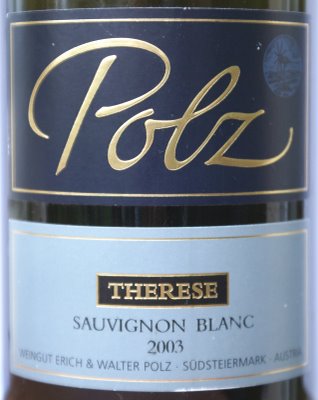Classy slate

Let’s look at another top estate from Austria: Erich & Walter Polz. Based in Southern Styria, the Polz family has been in the forefront of the winemaking revolution in this once incurably rural, and now cutting-edge-modern wine region.
Styria’s major advantage is its geological richness and variety of wine terroirs. Across a limited area, you can find marl, sandstone, volcanic basalt (brilliant soil for Pinot Gris and Gewürztraminer, two of the region’s best-performing varieties), opok (a compressed grey sandstone giving some stupendously mineral wines) and limestone. The latter is dominating in the top Styrian crus such as Grassnitzberg, Hochgrassnitzberg and Zieregg, on the border with Slovenia; these sites are yielding some very exciting wines from Sauvignon Blancs, perhaps the grape’s most interesting renditions outside the Upper Loire and Marlborough.
The wine I am drinking today – Sauvignon Blanc Therese 2003 (another older vintage unearthed in the cellar) – is from a different type of soil, however. Pure slate is most readily associated with the Rhine and Moselle Rieslings, and is a rather rare soil to grow Sauvignon on. The vineyard itself – Theresienhöhe – is also one of Styria’s highest at 450 meters. Grapes ripen well giving a very structured wine that is aged in wooden barrels. Oak-aged Sauvignon can often be clumsy, sacrificing the grape variety’s inherent freshness and exuberance for no apparent advantage. This wine is a different story.
Tasted last year while in Austria, the newly bottled 2007 was very terroir-driven, with impressive concentration for Sauvignon, and good acidic poise: just waiting to build proper complexity over five or six years in the bottle. It was markedly deeper and more mineral in expression than the Hochgrassnitzberg Sauvignon Blanc 2006, from a limestone vineyard: the latter is giving a more flowery, vegetal, expressive rendition of the grape. The Sauvignon Therese 2005 (from a pretty difficult vintage in Styria) was still showing quite young, but with a more rustic, meaty, grassy edge to it.
And here is this bottle of 2003. Could a Sauvignon from this torrid vintage have survived five years in the cellar? At the beginning there are some burnt rubber reductive aromas but with time, good gooseberry-scented freshness is showing up. Really a powerful wine in mouth, with substance and focus and a firm bitterish finish still. There is also an almost biting mineral charge: I think the acid-giving energy of slate has considerably helped this wine to survive and improve.
All in all, this was a fairly instructive bottle of wine. On paper, I would have dismissed it, looking at my tasting note from release when I remarked on the New-Worldish style of the wine (nettle and kiwi fruit), moderate substance and little complexity. Over half a decade, it has not only stood the test of time but developed good depth and improved its terroir references. This is a valid confirmation of the excellent job done by the Polz family in this uneasy vintage and of the sheer class of the Theresienhöhe slate. (I also very much recommend the Morillon Moth 2007, coming from the very same vineyard: a brilliantly fleshy, terroir-driven, unobese take on Chardonnay).

